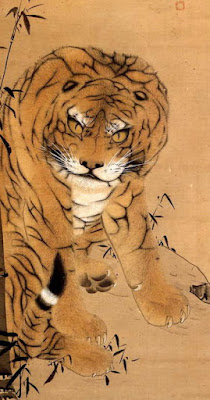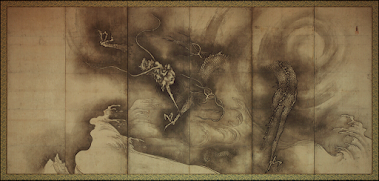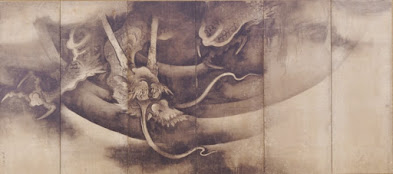
Edo period netsuke: Hare with Loquats © The Trustees of the British Museum
For those used to the Chinese Lunar New Year (which begins some time in late January or early February), it might seem strange that I habitually start the year with the animal of the coming year. In Japan, the Gregorian calendar was adopted at the end of 1872, with the 3rd day of the old 12th month becoming the 1st of January. Certain aspects of the old calendar were kept, and this included the system of assigning animals to each year. Thus, now each animal year begins on January 1st. (The old calendar system is interesting in its own right, and I will return to it briefly a bit later in this post).
It is, in any case, a chance to look at some examples of how animals were depicted in Japanese art. The Japanese themselves, if we allow such a generalisation, have preserved and curated their culture, presenting a broad narrative of themselves and their society that contrasts them to both their Asian neighbours and to the West. While this has inevitably smoothed off the rough edges, it has also been highly successful in preserving certain unique aspects of the culture. One of the largely unquestioned tenets of this view is that the Japanese are deeply respectful or appreciative of nature. While it would be easy to point out examples to contradict this, there is no denying the importance of the natural world in visual art. For hundreds of years, plants and animals have been seen as proper subjects for art, and feature repeatedly on any number of artifacts made for all ranks of society.
Rabbits Frolicking in the Waves (Kano Osanobu 1796-1846)
2023 is the Year of the Rabbit, or, perhaps more accurately, hare – the Japanese word usagi can refer to either. The hare appears early in Japanese mythology. The Kojiki, a collection of ancient tales and mythology, written down in the early 8th century, features a story with the white hare of Inaba. The motif of a white hare (or rabbit) in the waves found in Japanese art derives from this story – although is likely that the character that can be read as ‘white’ should more properly be read as ‘naked’, but white certainly makes for prettier pictures.
Hares have long been associated with the moon, and the symbol of the hare in the moon (the yang in yin) is counterbalanced by the three-legged crow in the sun (the yin in yang) in some schools of esoteric Daoism. In Japan, esoteric schools involving the sun and moon certainly existed, but I have not read of any strong esoteric connections with hares.
It also appeared as a motif in the armour and accoutrements of the bushi. Although the Edo period, when war was no longer a likelihood, saw a range of decorative helmets being produced, many individual and unusual designs were also produced during the 16th century, when war was still a regular state of affairs.
 | ||
| Helmet of the powerful warlord Uesugi Kenshin | (from the site 戦国カフェ) |

This is another helmet from the same period.
Note that that both of these examples include a crescent moon, preserving this ancient connection. There are a number of such helmets surviving, suggesting this was felt to be a suitable image for warriors to wear. While I haven’t seen any specific references to the attributes warriors admired in hares, modern explanations mention their speed, to which one might add their energy and ability to twist and turn to evade pursuit, as well as their ability to hide in the middle of nowhere, then explode into action. The ability to remain undetected in advance or retreat, was an important part of a warrior’s professional skills (and one connected with the bosatsu Marishiten). Depictions make much of the hare’s ears - natural enough, given how prominent they are, but this also suggests that for the warrior class they had specific relevance, related to their acute hearing, and by extension, awareness in general.
The ancient connection with the moon has not totally disappeared. Even today, if you look up at the full moon, the figure you can see is that of a rabbit pounding rice for mochi rice cakes (round and white like the moon), rather than ‘the man in the moon’ of western childhood lore, as you can see here:
This is a Daisho-reki calendar from 1867 (another year of the rabbit) – a type of calendar that served as a puzzle and a reminder for one of the problems associated with the old calendar, which was that every year the long and short (Daisho) months would not be the same. Daisho-reki calendars noted which months were long and which short, often in the form of a visual puzzle. In this case, the exaggerated brush strokes in the rabbit's clothes and mortar form the numbers 1 to 12; those in the rabbit are the short months while those in the pestle and mortar are the long months.
(The original can be found at the site of the Japanese National Diet Library https://www.ndl.go.jp/koyomi/e/quiz/q6.html)
Nowadays, rabbits are better known than hares. Nishimura Goun (1877-1938) is an example of a slightly more modern artist who was well known for his paintings of rabbits:
This is not just a modern trend, however. Edo period paintings such as this one by Nagasawa Rosetsu shows a pair of rabbits sitting quite happily beneath a snow covered nanten (nandina). This shrub is also associated with New Year, so it seems likely that this painting was painted as a decoration for a coming Year of the Rabbit.
https://www.fujibi.or.jp/en/our-collection/profile-of-works.html?work_id=9736
To all my readers, I wish you a Happy New Year - let's hope it's a good one!
(For anyone interested, I looked at rabbit and hare symbolism 12 years ago - how time flies!)
http://ichijoji.blogspot.com/2010/






























